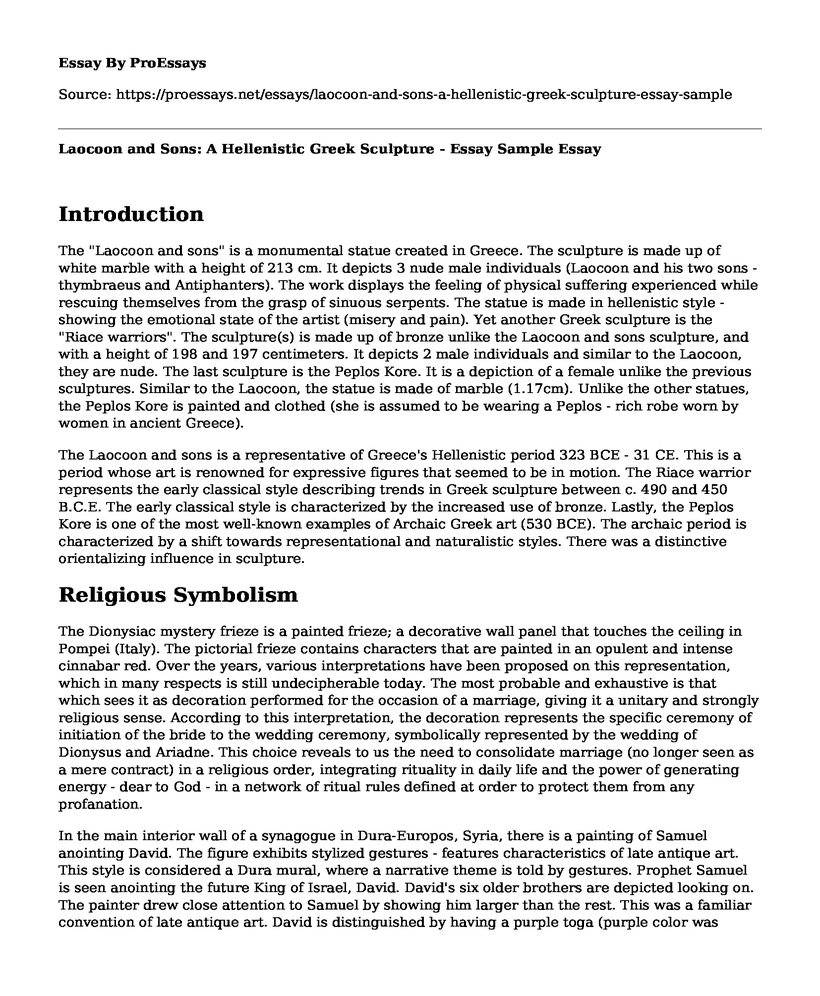Introduction
The "Laocoon and sons" is a monumental statue created in Greece. The sculpture is made up of white marble with a height of 213 cm. It depicts 3 nude male individuals (Laocoon and his two sons - thymbraeus and Antiphanters). The work displays the feeling of physical suffering experienced while rescuing themselves from the grasp of sinuous serpents. The statue is made in hellenistic style - showing the emotional state of the artist (misery and pain). Yet another Greek sculpture is the "Riace warriors". The sculpture(s) is made up of bronze unlike the Laocoon and sons sculpture, and with a height of 198 and 197 centimeters. It depicts 2 male individuals and similar to the Laocoon, they are nude. The last sculpture is the Peplos Kore. It is a depiction of a female unlike the previous sculptures. Similar to the Laocoon, the statue is made of marble (1.17cm). Unlike the other statues, the Peplos Kore is painted and clothed (she is assumed to be wearing a Peplos - rich robe worn by women in ancient Greece).
The Laocoon and sons is a representative of Greece's Hellenistic period 323 BCE - 31 CE. This is a period whose art is renowned for expressive figures that seemed to be in motion. The Riace warrior represents the early classical style describing trends in Greek sculpture between c. 490 and 450 B.C.E. The early classical style is characterized by the increased use of bronze. Lastly, the Peplos Kore is one of the most well-known examples of Archaic Greek art (530 BCE). The archaic period is characterized by a shift towards representational and naturalistic styles. There was a distinctive orientalizing influence in sculpture.
Religious Symbolism
The Dionysiac mystery frieze is a painted frieze; a decorative wall panel that touches the ceiling in Pompei (Italy). The pictorial frieze contains characters that are painted in an opulent and intense cinnabar red. Over the years, various interpretations have been proposed on this representation, which in many respects is still undecipherable today. The most probable and exhaustive is that which sees it as decoration performed for the occasion of a marriage, giving it a unitary and strongly religious sense. According to this interpretation, the decoration represents the specific ceremony of initiation of the bride to the wedding ceremony, symbolically represented by the wedding of Dionysus and Ariadne. This choice reveals to us the need to consolidate marriage (no longer seen as a mere contract) in a religious order, integrating rituality in daily life and the power of generating energy - dear to God - in a network of ritual rules defined at order to protect them from any profanation.
In the main interior wall of a synagogue in Dura-Europos, Syria, there is a painting of Samuel anointing David. The figure exhibits stylized gestures - features characteristics of late antique art. This style is considered a Dura mural, where a narrative theme is told by gestures. Prophet Samuel is seen anointing the future King of Israel, David. David's six older brothers are depicted looking on. The painter drew close attention to Samuel by showing him larger than the rest. This was a familiar convention of late antique art. David is distinguished by having a purple toga (purple color was associated with the Roman emperor and it signified royalty). In the Christian community, David was considered a warrior and became a symbol of hope against a formidable foe. The Christians of Dura-Europos hence crafted the memory of David as the anointed victor.
Transfiguration of Christ is symbolized in the Church of Saint' Apollinaire in Classe, 533-549 CE. In the upper part of the apsidal basin, there is a representation of the transfiguration of Christ on Mount Tabor: the redeemer is represented symbolically through the gem-shaped cross within a clypeus on a blue background, decorated with 99 gold stars. The image of Christ appears only in the center of the cross, within a medallion. At the end of the right arm is the Greek word ixzus (fish); while at the end of the lower arm we read salus mundi, on the sides the alpha and omega. Beside the jeweled disk, the busts of the Prophets Moses and Elijah emerge from the clouds. Twelve sheep are also shown. At the bottom stands, in the center, the figure of Saint Apollinaris in the act of praying. The proto-bishop is dressed in the purple robe (royalty again) adorned with bees. The 99 nine stars are the symbol of triumphant faith overall. The Greek word ixzus is an acrostic formed by the respective five initial letters of as many words of the same language that mean "Jesus Christ, son of God, Savior". The Latin inscription salus mundi alludes to the role of the Redeemer; the alpha and omega, the first and last letter of the Greek alphabet mean that Christ is the beginning and end of everything. Moses and Elijah are represented as prophets who attended the Ancient Covenant. The twelve sheep are the faithful who follow the saint, a good shepherd, to the pastures of eternal life. The figure of Saint Apollinaire Benedicens represents the intermediary between God and men.
Cite this page
Laocoon and Sons: A Hellenistic Greek Sculpture - Essay Sample. (2023, Mar 13). Retrieved from https://proessays.net/essays/laocoon-and-sons-a-hellenistic-greek-sculpture-essay-sample
If you are the original author of this essay and no longer wish to have it published on the ProEssays website, please click below to request its removal:
- Classification of Music: Essay Sample
- Fire and Ice: Symbolism in the Poetry of Robert Frost Essay
- Cindy Sherman Photography Essay
- Movie Analysis Essay on Amadeus
- Exploring Feminism & Women's Mass Media: Research Paper
- Essay on Enhance Your Appearance With Makeup: Different Reasons for Different Women
- The Big Short - Movie Analysis Essay







